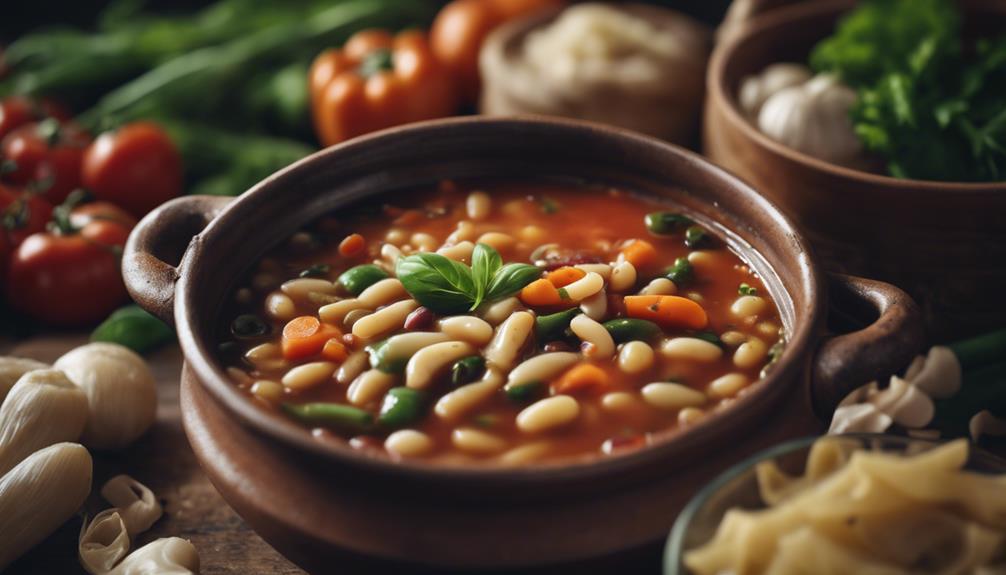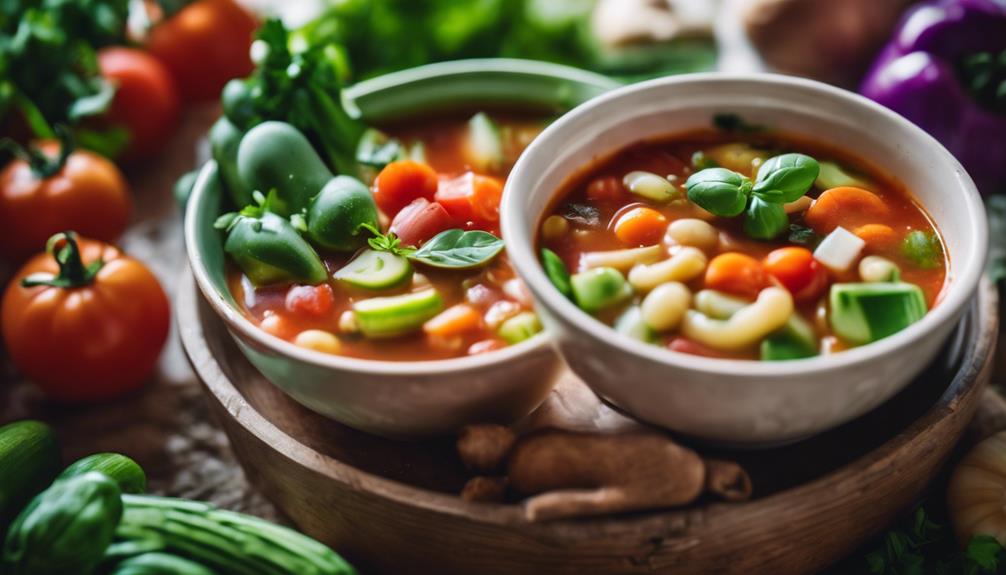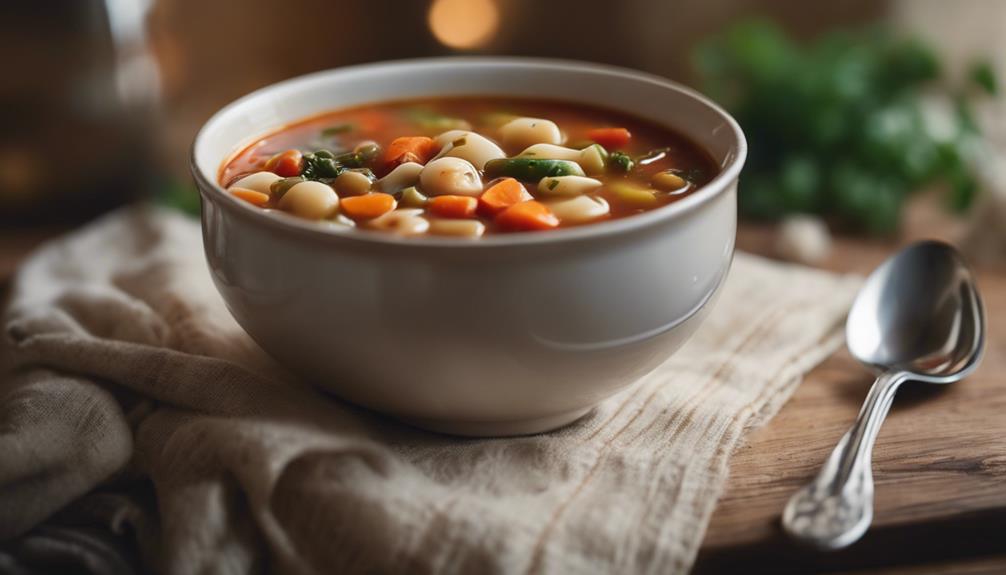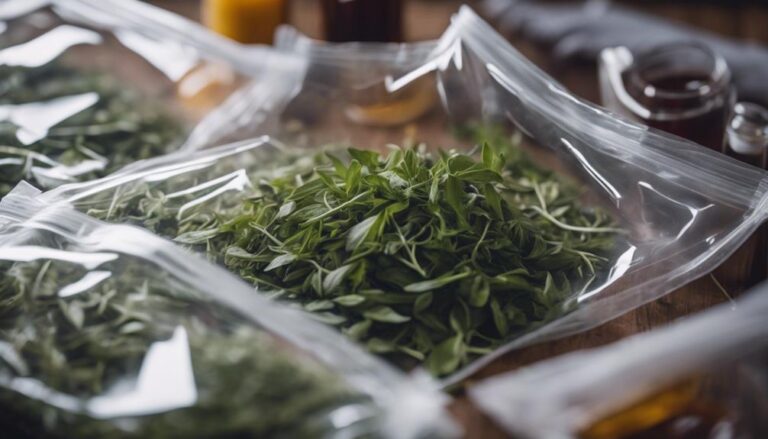Vegetable Minestrone Soup
For a delicious Vegetable Minestrone Soup, gather seasonal veggies like tomatoes, carrots, and celery. Add herbs such as garlic, basil, and oregano for a flavorful touch. Beans and pasta provide heartiness and protein, creating a satisfying soup experience. Modern twists include a variety of vegetables, beans, broth, and herbs for diverse flavors. Experiment with ingredient pairings like mushrooms and barley, enriching taste and texture. Enhance flavors with different spices and cooking techniques. Craft a nutritious meal filled with culinary creativity and historical roots. Uncover the secrets behind this timeless favorite.
What You Will Learn Here
- Traditional minestrone includes seasonal vegetables, beans, pasta, and herbs for a flavorful base.
- Modern adaptations incorporate a variety of vegetables, beans, flavorful broth, and herbs for a dynamic taste.
- Mushroom and barley add nutritional benefits, savory flavors, and hearty textures to the soup.
- Culinary creativity shines with mushroom varieties and barley pairing for enhanced taste and texture.
- Experiment with ingredient combinations, spices, and cooking techniques to elevate the flavor profile of Vegetable Minestrone Soup.
Origin of Minestrone Soup

Minestrone soup has a rich history that dates back centuries, showcasing the culinary traditions of various regions.
Traditional ingredients like beans, vegetables, and pasta have been staples in this hearty dish.
Over time, minestrone has evolved to include a wide array of ingredients, making it a versatile and customizable soup option.
Minestrone Soup History
Originating from the Mediterranean region, this hearty vegetable soup has a rich history that dates back centuries. Italian cuisine, known for its robust flavors and fresh ingredients, plays a significant role in the creation of minestrone soup. This dish is deeply rooted in Italian culinary traditions, reflecting the simplicity and versatility that characterize Mediterranean cooking.
The history of minestrone soup is closely tied to the concept of cucina povera, which translates to 'poor kitchen' in Italian. This style of cooking emphasizes making delicious meals with humble, readily available ingredients. Minestrone soup embodies this philosophy by incorporating a variety of vegetables, legumes, and sometimes pasta or rice, creating a nourishing and satisfying dish.
Throughout history, minestrone soup has evolved to include regional variations, with each Italian region adding its own twist to the classic recipe. Despite these variations, the essence of minestrone soup as a hearty vegetable-based dish has remained consistent, showcasing the enduring popularity of this beloved Italian staple. Its lasting presence on tables worldwide is a confirmation of its delicious simplicity and rich culinary heritage.
Traditional Minestrone Ingredients
With its roots in Italian culinary traditions and the concept of cucina povera, the ingredients used in traditional minestrone soup reflect a history of resourcefulness and flavor innovation. Seasonal vegetables play an essential role in this classic recipe, offering a dynamic array of flavors and textures. Common vegetables found in minestrone include tomatoes, carrots, celery, onions, zucchini, and green beans, creating a vibrant and nutritious base for the soup.
In addition to the seasonal vegetables, traditional flavors like garlic, basil, and oregano enhance the taste profile of this beloved dish. These herbs add depth and richness to the minestrone, providing a comforting and familiar taste that has stood the test of time. Nutritious additions such as beans and pasta are also staples in this soup, contributing protein and heartiness to the recipe.
Evolution of Minestrone
The evolution of vegetable minestrone soup can be traced back to ancient Roman times, where early versions of this hearty dish were created using locally available ingredients. Over the centuries, minestrone has undergone various transformations influenced by cultural shifts and culinary innovations. Modern adaptations of minestrone reflect a blend of traditions and contemporary tastes, with a wide range of ingredients beyond the original ones like beans, tomatoes, and pasta.
Regional variations play a significant role in shaping minestrone, with different areas of Italy and the world adding their unique touch to the recipe. Seasonal ingredients also impact the flavor profile of minestrone, with summer versions featuring fresh basil and zucchini, while winter variations might include hearty root vegetables like carrots and parsnips.
The evolution of minestrone showcases how a simple peasant soup has evolved into a beloved dish enjoyed worldwide, adapting to changing tastes and culinary trends while still holding onto its rustic roots.
Key Soup Components
For a flavorful Vegetable Minestrone Soup, focus on essential ingredients that include fresh vegetables, hearty beans, and savory broth. When crafting your soup, consider the following key components:
- Variety of Vegetables: Incorporating a mix of colorful vegetables like carrots, celery, zucchini, and tomatoes not only adds different textures to your soup but also enhances the flavor profile with each bite.
- Hearty Beans: Beans such as cannellini beans or kidney beans not only provide a satisfying texture to the soup but also contribute to its protein content, making the dish more filling and nutritious.
- Flavorful Broth: A rich and savory broth, whether homemade or store-bought, forms the base of your soup and infuses all the other ingredients with delicious flavors. Consider using vegetable broth for a vegetarian option or chicken broth for added depth.
- Herbs and Spices: Don't forget to season your soup with herbs like basil, oregano, and thyme, along with spices such as garlic and black pepper to elevate the overall taste and aroma of your Vegetable Minestrone Soup.
Top Minestrone Soup Picks

When it comes to top picks for Minestrone soup, you can't go wrong with the Hearty Vegetable Medley Recipe, the Zesty Tomato Basil Soup, or the Mushroom and Barley Medley. These options offer a diverse range of flavors and textures that are sure to satisfy your soup cravings.
Whether you're in the mood for something rich and hearty or light and invigorating, these top picks have got you covered.
Hearty Vegetable Medley Recipe
Incorporate vibrant vegetables to elevate your minestrone soup experience with this hearty medley recipe bursting with flavor.
- Abundance of Vegetables: Load your minestrone with a colorful array of vegetables like carrots, zucchini, bell peppers, and tomatoes for a hearty and nutritious meal.
- Seasoned to Perfection: Enhance the flavors of your vegetable medley with a blend of aromatic herbs and spices such as oregano, basil, and a hint of garlic for that extra zing.
- Protein-Packed Additions: Consider adding protein-rich ingredients like beans or tofu to make your minestrone a filling and satisfying vegetarian option that doesn't compromise on taste.
- Customizable Creations: Make this medley your own by experimenting with different vegetables, adjusting the seasoning to suit your taste preferences, and serving it with a side of crusty bread for a wholesome meal.
With these simple tips, you can create a minestrone soup that not only delights your taste buds with its hearty flavors but also provides a nourishing vegetarian option for your next meal.
Zesty Tomato Basil Soup
Indulge in the robust flavors of a zesty Tomato Basil Soup, a top pick for your next minestrone soup adventure. This vibrant soup combines the tangy richness of tomatoes with the fresh aroma of basil, creating a delightful culinary experience that will tantalize your taste buds.
Markdown List:
- Fresh Basil Pesto: Elevating the soup with a burst of fragrant basil flavors.
- Velvety Tomato Bisque: Providing a smooth, creamy texture that complements the basil infusion.
- Perfectly Balanced: The savory tomatoes harmonize flawlessly with the herbal notes of basil pesto.
- Versatile Delight: Enjoy it as a standalone soup or pair it with a crusty bread for a satisfying meal.
Whether you savor a warm bowl on a chilly evening or serve it as a starter for a special dinner, this Tomato Basil Soup is sure to impress. The marriage of ripe tomatoes and aromatic basil pesto creates a symphony of flavors that will leave you craving more. Experience the comfort and warmth of this classic soup that never fails to delight.
Mushroom and Barley Medley
Explore the rich flavors and hearty textures of Mushroom and Barley Medley, a top choice for your minestrone soup repertoire. This medley combines the earthy goodness of mushrooms with the nutty chewiness of barley, creating a satisfying addition to your soup. Here are some key points to take into account when incorporating Mushroom and Barley Medley into your cooking routine:
- Mushroom benefits:
Mushrooms are a low-calorie food packed with nutrients like vitamins B and D, along with essential minerals. They add a savory umami flavor to dishes, enhancing the overall taste of your soup.
- Barley nutrition:
Barley is a whole grain rich in fiber, antioxidants, and important nutrients like manganese and selenium. It provides a hearty, chewy texture to the medley, making your soup more filling and nutritious.
- Culinary creativity:
Experiment with different mushroom varieties like cremini, shiitake, or portobello to add depth to your dish. Pairing barley with mushrooms creates a delightful combination of flavors and textures that will elevate your minestrone soup.
- Ingredient pairing:
The combination of mushrooms and barley complements other vegetables in your minestrone, enhancing the overall taste profile of the soup. This medley adds a satisfying element to your meal, making it a top pick for a wholesome and delicious dining experience.
Enhancing Soup Flavors
To enhance the flavors of your vegetable minestrone soup, consider experimenting with flavorful ingredient combinations, spice and herb pairings, and various cooking techniques.
These elements can greatly impact the taste and depth of your soup, elevating it from ordinary to extraordinary.
Flavorful Ingredient Combinations
Enhance the flavors of your Vegetable Minestrone Soup by combining ingredients thoughtfully to create a delicious and robust taste profile.
Start by selecting seasonal produce, such as ripe tomatoes, zucchini, and hearty greens like kale or spinach. Seasonal vegetables not only offer the best flavors but also guarantee freshness and maximum nutrient content.
Let your culinary creativity shine by experimenting with different vegetable combinations. For example, try adding sweet corn for a hint of natural sweetness or bell peppers for a pop of color and a slightly tangy flavor.
Consider incorporating ingredients like butternut squash or sweet potatoes for a creamy texture and subtle sweetness. These additions can complement the savory notes of the soup base beautifully.
Moreover, don't shy away from including aromatic vegetables like garlic, onions, and leeks to build a flavorful foundation.
Spice and Herb Pairings
Consider spicing up your Vegetable Minestrone Soup with a harmonious blend of herbs and spices to elevate its flavors to a new level. Herb pairings such as basil, oregano, and thyme can add depth and freshness to your soup. Basil brings a sweet, aromatic note, while oregano offers a robust, earthy flavor. Thyme contributes a subtle, savory taste that enhances the overall profile of the dish. Experiment with different combinations to find your preferred mix of herb flavors.
In addition to herbs, seasoning tips like using garlic powder, onion powder, and a dash of red pepper flakes can further enhance the taste of your Vegetable Minestrone Soup. Garlic powder adds a rich, savory undertone, while onion powder provides a sweet and mild flavor. A pinch of red pepper flakes can bring a hint of heat to the soup, balancing out the other flavors.
Cooking Techniques Impact
Experiment with different cooking techniques to reveal the full potential of flavors in your Vegetable Minestrone Soup. The way you cook your ingredients can have a substantial impact on the taste of your soup. Ingredient pairing plays an important role in enhancing the overall flavor profile. For instance, sautéing aromatic vegetables like onions, garlic, and carrots before adding broth can bring out their natural sweetness and depth of flavor.
Consider using a variety of cooking methods to add layers of taste to your minestrone. Simmering the soup slowly allows the flavors to meld together, creating a rich and harmonious blend. Roasting certain vegetables like tomatoes or bell peppers can intensify their sweetness, providing a delicious contrast to the savory elements in the soup.
Experiment with techniques such as blanching or braising to add different textures and flavors to your Vegetable Minestrone Soup. By exploring various cooking methods and ingredient pairings, you can elevate the taste of your soup to a whole new level.
Final Thoughts

Reflecting on the flavors and textures experienced throughout this culinary journey, one can't deny the comforting harmony found in each spoonful of this Vegetable Minestrone Soup. The nutrition benefits of this hearty soup are abundant, with a variety of vegetables providing essential vitamins, minerals, and fiber. The colorful medley of ingredients not only adds to the visual appeal but also contributes to a well-balanced meal that can support your overall health and well-being.
When it comes to serving suggestions, this Vegetable Minestrone Soup offers versatility. You can enjoy it as a satisfying standalone dish or pair it with a side of crusty bread or a fresh green salad for a more substantial meal. The soup also tastes delicious topped with a sprinkle of grated Parmesan cheese or a drizzle of extra virgin olive oil for an added depth of flavor.
Frequently Asked Questions
Can Minestrone Soup Be Made in a Slow Cooker?
Yes, minestrone soup can be made in a slow cooker. Using a slow cooker offers numerous benefits like convenience and enhanced flavors. Many delicious slow cooker recipes, including minestrone, can be easily prepared for a comforting meal.
Is It Possible to Freeze Leftover Minestrone Soup?
Yes, you can freeze leftover minestrone soup. It extends its shelf life for convenient future meals. When reheating, utilize stovetop or microwave methods for best results. Enjoy your saved time and effort with this freezing option.
Are There Any Gluten-Free Options for Minestrone Soup?
If you're looking for gluten-free options for your minestrone soup, consider using gluten-free pasta alternatives and vegetable broth substitutions. These swaps can help you enjoy a delicious and safe meal.
Can Minestrone Soup Be Made Without Tomatoes?
Yes, you can make minestrone soup without tomatoes. Consider using tomato alternatives like red bell peppers or beetroot for a similar color and flavor. This modification opens up allergen-friendly variations and provides a unique twist to the classic recipe.
What Are Some Creative Toppings for Minestrone Soup?
Want to elevate your minestrone soup? Try savory crouton alternatives for crunch and fresh herb garnishes for added flavor. These creative toppings will take your soup to the next level in taste and texture.
Conclusion
To sum up, vegetable minestrone soup is a hearty and nutritious dish that has been enjoyed for centuries. With a variety of vegetables, beans, and pasta, it's a versatile and satisfying meal that can be customized to suit your taste preferences.
By incorporating fresh herbs and spices, you can enhance the flavors of this classic soup even further. Whether enjoyed as a starter or main course, vegetable minestrone soup is a timeless favorite that's sure to please any palate.











